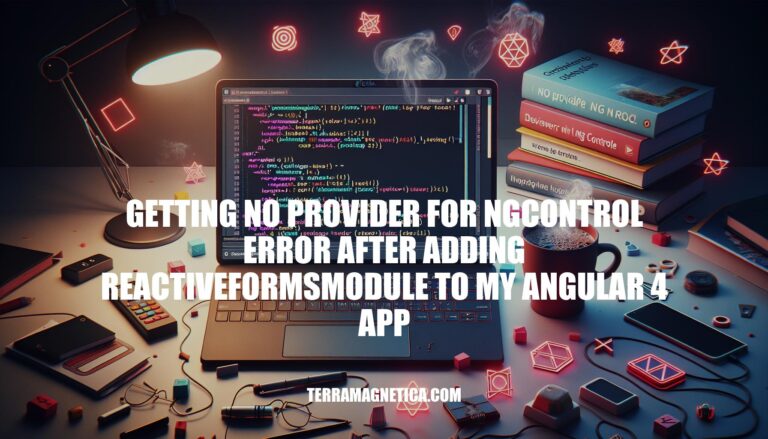


When developing an Angular 4 application, you might encounter the “No provider for NgControl” error after adding the ReactiveFormsModule. This error typically occurs because the ReactiveFormsModule has not been properly imported into the module where the reactive form is being used.
This error is significant in Angular development as it highlights the importance of correctly configuring modules and dependencies. Without resolving this issue, the reactive forms won’t function as expected, leading to potential disruptions in form handling and validation within the application. Properly importing and configuring the necessary modules ensures smooth and efficient development workflows.
The “No provider for NgControl” error in Angular occurs when the Angular forms module isn’t properly configured. This error typically happens after adding ReactiveFormsModule to an Angular 4 app because the necessary providers for form controls are missing.
ReactiveFormsModule might not be imported in the module where the form is being used.ReactiveFormsModule must be imported in that child module as well.ReactiveFormsModule.ReactiveFormsModule in individual components instead of the module, leading to this error.By ensuring ReactiveFormsModule is correctly imported in the relevant modules, this error can be resolved.
Here are the common causes of the “No provider for NgControl” error after adding ReactiveFormsModule to an Angular 4 app:
Missing Imports:
ReactiveFormsModule is imported in the module where the form is being used.import { ReactiveFormsModule } from '@angular/forms';
@NgModule({
imports: [ReactiveFormsModule]
})
export class YourModule { }
Incorrect Module Configuration:
ReactiveFormsModule must be imported in that child module as well.@NgModule({
imports: [CommonModule, ReactiveFormsModule]
})
export class ChildModule { }
Component Hierarchy Issues:
@Component({
selector: 'app-your-component',
templateUrl: './your-component.component.html',
providers: [{ provide: NG_VALUE_ACCESSOR, useExisting: forwardRef(() => YourComponent), multi: true }]
})
export class YourComponent implements ControlValueAccessor { }
Incorrect Usage of Directives:
formGroup, formControl, etc., are used correctly within the template.<form [formGroup]="yourForm">
<input formControlName="yourControl">
</form>
Module Hierarchy Issues:
ReactiveFormsModule is available in the scope where the form is being used.By addressing these common issues, you should be able to resolve the “No provider for NgControl” error in your Angular 4 app.
Here’s a detailed, step-by-step guide to troubleshoot and resolve the ‘No provider for NgControl’ error after adding ReactiveFormsModule to an Angular 4 app:
ReactiveFormsModuleEnsure that you have imported ReactiveFormsModule in your app module.
import { BrowserModule } from '@angular/platform-browser';
import { NgModule } from '@angular/core';
import { ReactiveFormsModule } from '@angular/forms';
import { AppComponent } from './app.component';
@NgModule({
declarations: [
AppComponent
],
imports: [
BrowserModule,
ReactiveFormsModule // Add this line
],
providers: [],
bootstrap: [AppComponent]
})
export class AppModule { }
Create a component and set up a reactive form.
import { Component, OnInit } from '@angular/core';
import { FormBuilder, FormGroup, Validators } from '@angular/forms';
@Component({
selector: 'app-login',
templateUrl: './login.component.html'
})
export class LoginComponent implements OnInit {
loginForm: FormGroup;
constructor(private fb: FormBuilder) {}
ngOnInit() {
this.loginForm = this.fb.group({
username: ['', Validators.required],
password: ['', Validators.required]
});
}
onSubmit() {
console.log(this.loginForm.value);
}
}
Update the template to use the reactive form.
<form [formGroup]="loginForm" (ngSubmit)="onSubmit()">
<div>
<label for="username">Username</label>
<input id="username" formControlName="username">
</div>
<div>
<label for="password">Password</label>
<input id="password" formControlName="password" type="password">
</div>
<button type="submit">Login</button>
</form>
Ensure that ReactiveFormsModule is imported in the module where your component is declared. If your component is part of a feature module, import ReactiveFormsModule there as well.
import { NgModule } from '@angular/core';
import { CommonModule } from '@angular/common';
import { ReactiveFormsModule } from '@angular/forms';
import { LoginComponent } from './login.component';
@NgModule({
declarations: [LoginComponent],
imports: [
CommonModule,
ReactiveFormsModule // Add this line
]
})
export class LoginModule { }
Ensure that your Angular app is correctly configured to use reactive forms. Check for any typos or missing imports.
Sometimes, changes are not picked up immediately. Restart your development server to ensure all changes are applied.
ng serve
If the error persists, check the console for any additional errors or warnings that might give more context. Ensure that all dependencies are correctly installed and up-to-date.
By following these steps, you should be able to resolve the ‘No provider for NgControl’ error in your Angular 4 app.
Here are some best practices to avoid the “No provider for NgControl” error in Angular 4:
Import ReactiveFormsModule:
ReactiveFormsModule is imported in the module where your form components are declared.import { ReactiveFormsModule } from '@angular/forms';
@NgModule({
imports: [ReactiveFormsModule],
declarations: [YourComponent]
})
export class YourModule { }
Shared Module:
ReactiveFormsModule.@NgModule({
imports: [ReactiveFormsModule],
exports: [ReactiveFormsModule]
})
export class SharedModule { }
Correct Imports:
FormBuilder, FormGroup, and FormControl from @angular/forms in your component.import { FormBuilder, FormGroup, FormControl } from '@angular/forms';
Avoid Duplicate Imports:
ReactiveFormsModule in multiple places unnecessarily. Import it only in the module where it’s needed.Form Initialization:
ngOnInit method.constructor(private fb: FormBuilder) {
this.myForm = this.fb.group({
controlName: ['']
});
}
Template Binding:
[formGroup] and formControlName directives correctly in your template.<form [formGroup]="myForm">
<input formControlName="controlName">
</form>
Validation:
this.myForm = this.fb.group({
controlName: ['', Validators.required]
});
By following these practices, you can avoid the “No provider for NgControl” error and ensure smooth form handling in your Angular application.
To resolve the No provider for NgControl error in an Angular 4 application after adding ReactiveFormsModule, ensure that you have properly configured your modules by importing ReactiveFormsModule in the necessary modules, such as the feature module where forms are used.
Avoid duplicate imports and unnecessary imports of ReactiveFormsModule. Create a shared module to import and export ReactiveFormsModule if multiple modules use reactive forms.
Properly initialize your form in the component’s constructor or ngOnInit method using FormBuilder from @angular/forms. Use [formGroup] and formControlName directives correctly in your template to bind the form controls to the FormGroup instance.
Adhere to best practices by importing necessary validators, such as Validators.required, during form control initialization. By following these guidelines, you can avoid the No provider for NgControl error and ensure smooth form handling in your Angular application.